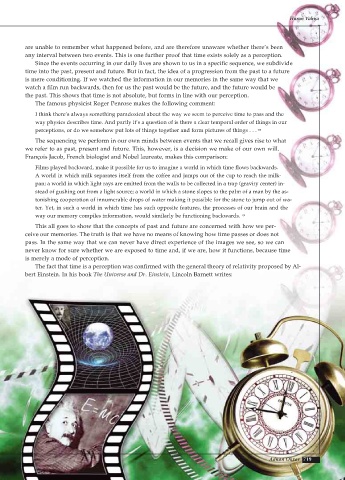Page 721 - Atlas of Creation Volume 4
P. 721
Harun Yahya
are un a ble to re mem ber what hap pened be fore, and are there fore un a ware wheth er there’s been
any in ter val be tween two events. This is one fur ther proof that time ex ists sole ly as a per cep tion.
Since the events oc cur ring in our dai ly lives are shown to us in a spe cif ic se quence, we sub di vide
time in to the past, present and fu ture. But in fact, the idea of a pro gres sion from the past to a fu ture
is mere con di tion ing. If we watched the in for ma tion in our mem o ries in the same way that we
watch a film run backwards, then for us the past would be the fu ture, and the fu ture would be
the past. This shows that time is not ab so lute, but forms in line with our per cep tion.
The fa mous phys i cist Roger Penrose makes the fol low ing com ment:
I think there’s al ways some thing par a dox i cal about the way we seem to per ceive time to pass and the
way phys ics de scribes time. And part ly it’s a ques tion of is there a clear tem po ral or der of things in our
per cep tions, or do we some how put lots of things to geth er and form pic tures of things . . . 130
The se quen cing we per form in our own minds be tween events that we re call gives rise to what
we re fer to as past, present and fu ture. This, how e ver, is a de ci sion we make of our own will.
Fran ço is Ja cob, French biologist and Nobel laureate, makes this com par i son:
Films played back ward, make it pos si ble for us to im ag ine a world in which time flows back wards.
A world in which milk sep a rates it self from the cof fee and jumps out of the cup to reach the milk-
pan; a world in which light rays are emit ted from the walls to be col lect ed in a trap (grav i ty cen ter) in -
stead of gush ing out from a light source; a world in which a stone slopes to the palm of a man by the as -
ton ish ing co op er a tion of in nu mer a ble drops of wa ter mak ing it pos si ble for the stone to jump out of wa -
ter. Yet, in such a world in which time has such op po site fea tures, the proc ess es of our brain and the
way our mem o ry com piles in for ma tion, would sim i lar ly be func tion ing back wards. 131
This all goes to show that the con cepts of past and fu ture are con cerned with how we per -
ceive our mem o ries. The truth is that we have no means of know ing how time pass es or does not
pass. In the same way that we can nev er have di rect ex pe ri ence of the im a ges we see, so we can
nev er know for sure wheth er we are ex posed to time and, if we are, how it func tions, be cause time
is mere ly a mode of per cep tion.
The fact that time is a per cep tion was con firmed with the general theory of relativity pro posed by Al-
bert Einstein. In his book The Universe and Dr. Einstein, Lincoln Barnett writes:
Adnan Oktar 719

